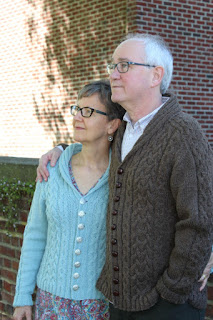Crochet Primer: Tools & Setup
Even though figknits is primarily a knitting blog, I think it's good for every knitter to know how to crochet at least a little. Today we begin a series of posts about crochet. I hope this week's posts will help you become interested in learning about this very worthy craft!
One disclaimer is needed: I apologize to all lefties who will probably now leave me (don't go away mad!), but I am a rightie and all instruction afterward is shown in rightie style. I love lefties, but am severely right-handed. Here's a great site for lefties who want to crochet.
Crochet actually requires fewer tools than knitting, and you can go far with just a hook, some stitch markers, and a yarn needle. Just as with knitting needles, there are hooks made in almost every conceivable material. I'll show you just a representation of the ones in my hook case.

From left to right, you see a plain bamboo hook, a Kollage Square hook, an aluminum hook, a ChiaoGoo bamboo-handled hook (which are still woefully hard to find), a rosewood hook, another bamboo hook but with a fancy turned handle, and a rosewood hook also with fancy turned handle. Whichever you choose to use depends on what's comfortable and pleasing for you. As far as I know, there used to exist only the aluminum hooks, and I crocheted for many years with these. Now, however, I'm more likely to choose one of the wooden ones, especially the ChiaoGoo ones. I've already told you how ga-ga I am about these in earlier posts, so I won't go into that here. If you know a retailer that carries these hooks, please let me know. As far as I know ChiaoGoo is the only company making hooks like these.
You may notice that I do not include steel crochet hooks. These usually come much smaller for making fine crocheted lace and doilies. I am confining this tutorial to crochet with yarn. Steel crochet hooks are for use with thread. To choose which hook to use with which yarn, please consult the Yarn Standards guide.
Back to the picture above--you can also see my favorite locking stitch markers* from Clover and my favorite Chibi set of yarn needles also from Clover. You can get these with either bent or straight tips. I love the bent ones--great for getting into the fabric.
*I send you to Angelika for some markers--she has all kinds. Scroll down to see the locking ones like in the picture.
Okay, enough about products. Let's get started!
Just as in knitting, once you've chosen your yarn and an appropriate hook, you will make a slip knot to secure the yarn to the hook (needle) and to form the first stitch.

With the yarn end facing you and leaving at least 6" to work in later, make a loop.

With your thumb, poke the yarn end up through the loop. Insert the hook into the loop, from right to left.

Pull down on the yarn end and then the working yarn to snug the knot up against the underside of the hook, but not too tightly. Now let's talk about how to hold the hook.
Every crocheter holds his or her hook differently. I hold my hook like a pencil. Some people hold theirs under their hand, like you would if you were holding a wooden spoon to stir cookie dough, or what's called the knife hold. Here's a site that shows both. You choose what works for you.
 The last part of today's message is about wrapping the yarn around your left fingers to create an even tension. The way I was taught by Granny Kate was to wrap the yarn around your little finger, behind the ring and middle fingers and up over the top of the index finger. Then as you crochet, you will work a variety of loops around your index finger in accordance with how much "leader" yarn you have or want to have available. This all comes more naturally, of course, the more you practice.
The last part of today's message is about wrapping the yarn around your left fingers to create an even tension. The way I was taught by Granny Kate was to wrap the yarn around your little finger, behind the ring and middle fingers and up over the top of the index finger. Then as you crochet, you will work a variety of loops around your index finger in accordance with how much "leader" yarn you have or want to have available. This all comes more naturally, of course, the more you practice.I now leave you to gather some tools, practice your slip knot, decide how you like to hold your hook, and try wrapping the yarn around your left fingers. Have fun!
Also, have a look at the pattern I have up for free that teaches you how to crochet: The Learn to Crochet Cowl.
Next time, we learn to chain!

Comments